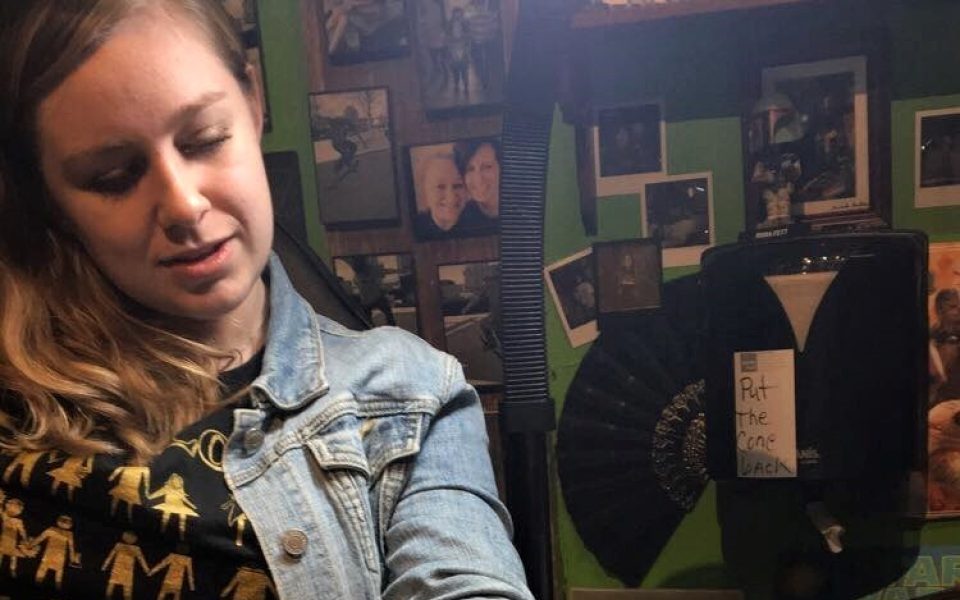Face paint, glitter and rainbow flags adorn Trade Street of Winston-Salem on a sunny fall Saturday afternoon for Pride Weekend’s festivities. A chalkboard sign beckons the crowd inside a shop with a lime green door — Tattoo Revival.
Inside the tattoo and piercing studio, two flash sheets boasting rainbow designs, unicorns and Freddie Mercury lay among the usual portfolios. For Pride, Tattoo Revival celebrates the convergence of LGBTQ culture with body art, showing how the two communities have historically intertwined.
In the back room, Taylor Alouf nervously awaits her first inking after six years of planning. An ally, she stands in solidarity with her roommate Meli Fonseca, a member of the LGBTQ community who had just finished her own session. The simple design stenciled on her wrist — the word “love” followed by a semicolon — fits in nicely with the attitude of Pride.
The buzzing signals the start of the tattooing process, and Alouf puts on a brave face. To distract herself, she rambles off the names of the latest cat she fostered.
“Adam Rainbow.” She stops and starts over. “Adam Ziggy Rainbow.” She pauses. “Adam Ziggy Rainbow Sparrow, and what was his last name?” She takes a breather. “Amber Twilight.”
The artist, Mallory Blalock, comforts her: “Look, we’re already halfway done.”
Fonseca reminds her to breathe, and the banter continues as such until a wipe of Vaseline leaves Alouf somewhat in awe.
“Look at that,” she marvels. “It is on my arm!”
Her design centers self-love and compassion. Fonseca’s has a somewhat similar message. The equality symbol is bold on the side of her wrist, stark black lines standing out against pale skin. The shape has been a strong icon for LGBTQ groups and presents a manner for Fonseca to wear her heart on her sleeve.
“I got it, in a kinda subtle, not in-your-face way, to remind myself and have it present in other people’s minds that pride is important to me,” she says.
Tattoos and body art have often been used as a physical manifestation of personality. The individuality of the artform draws Mallory Blalock to this work.
“I enjoy it because it allows me to get to know a lot of different people as well as them getting to know people who are different to them,” she explains.
With bobbleheads and other trinkets around her booth, Blalock hopes to display, in her words, “The whole gay agenda.” The studio attracts people of all kinds, and some may not be as accepting as others. Face-to-face experiences such as these, however, create a platform for open communication.
The parallels manifest themselves in other forms of body art, too. As piercer John Pendergrass points out, the modern American piercing community has its roots in more “behind-the-scenes” LGBTQ subgroups.
As he rubs an amber-colored scrub over a client’s earlobe, he clarifies the acceptance he has found in the body art community, even without naming his identity.
“I can be comfortable with who I am without putting labels on it,” he says.
A level of decisiveness and self-determination presents itself among the LGBTQ and body art communities, through historical context and personal exploration. A frequent visitor of the studio, Charlie Lawson, illustrates the concept by rolling up a sleeve and turning around to show the back of his leg. Tattoos can often be hidden, as can these identities.
“I have to actively choose to show how queer I am,” he notes. Having begun his body-art journey with a home-made tattoo at age 15, Lawson’s lived years with his body art and gay identity paralleling one another. Like others, Lawson considers visibility key to destigmatizing both body art and LGBTQ identity.
“At their core, they’re both originally underground cultures,” he points out.
“Pride is a good excuse for us and a safe place for us to actually express who we are without being afraid,” Blalock says. “And the same thing with tattoos, right? We want to put that on our body and be proud of it, to show and take ownership of it.”
Join the First Amendment Society, a membership that goes directly to funding TCB‘s newsroom.
We believe that reporting can save the world.
The TCB First Amendment Society recognizes the vital role of a free, unfettered press with a bundling of local experiences designed to build community, and unique engagements with our newsroom that will help you understand, and shape, local journalism’s critical role in uplifting the people in our cities.
All revenue goes directly into the newsroom as reporters’ salaries and freelance commissions.


Leave a Reply